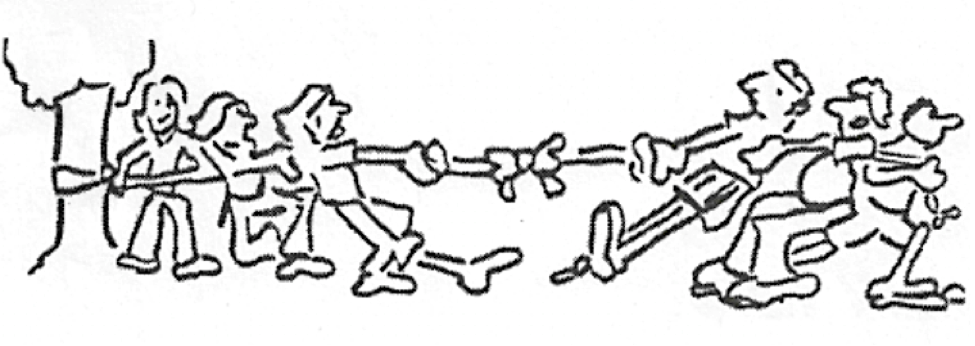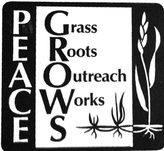Six-step problem solving is a focused means of consensus decision-making in a group.
|
1. For a group to solve a problem, what task-oriented roles must be performed?
|
2. Once initiated, group problem solving requires what maintenance roles?
|
|
Click here to move slide
|
Click here to move slide
|
|
|
Do you find yourself with BLOCKERS?
|
Click here to move slide
|
This playlist shows examples of five blocking roles.
|
"What is Consensus?"
"The consensus process is not something that takes place solely in the meeting. It is an ongoing process between actual meeting times. It necessitates that the disagreeing parties carry on communications in a less formal way outside the meeting situation"
Excerpt from the "What is consensus?" article, written by John Looney.
|
| ||
|
"SIX STEP PROBLEM SOLVING"
In most cases this procedure has proven very helpful in accelerating group decision making and meaningful action. It focuses on group attention while enabling movement toward consensus.
1. Brainstorm a list of the problems 2. Choose one of those problems. 3. Describe or clarify that problem 4. Brainstorm a list of possible solutions. 5. Chose the best solution as in Step #2. 6. Decide how to implement that solution. Other problems and considerations need not be dropped permanently but can be returned to later if and when appropriate.
| |||
Here are three cases involving young people learning about consensus and brainstorming...
Case Study: |
Zeroing in on a Problem
|
They are then asked to begin again, but first must lay ground rules, such as: a) everyone has the right to an opinion, b) everyone must have equal opportunity to speak, c) there will be no name calling, d) differences of opinion are settled by a vote. This activity has several positive effects. The most important one is that students who tend to dominate discussion learn to listen to other students who are normally passive. Students develop a sense of group unity. And finally, many creative ideas flow as the group becomes involved in discussion. The consensus skill is one that must be developed in the classroom if students are to be expected to participate in an active and positive way in the larger society. Submitted by a teacher from the Shaker Heights School District, Cleveland, Ohio, while taking the ALTERNATIVES TO VIOLENCE course. The students are demonstrating the use of steps 1-4 from the article "Six Steps to Problem Solving." Also, the teacher is trying to teach consensus, as introduced in this session. The kids used necessary skills such as active listening, clear stating, proposing ideas, negotiation, mediating, etc. |
Case Study: |
Those Darn Kids
|
Problem:Being Rude To Someone Younger. What Are Other Responses?
Submitted by a teacher from Akron, Ohio, city schools while taking the ALTERNATIVES TO VIOLENCE course. This case study is an example of how to effectively implement brainstorming and when brainstorming can be used. Brainstorming was implemented in step 1 and step 4 in the "Six Steps to Problem Solving Article." |
Case Study: |
A Wave of Ideas
|
Problem to be addressed: What Would You Do If Some Big Kids Gave You Pills (Drugs) And Wanted You To Take Them? We were seated on our carpet area and I recorded the children’s ideas on a chart. The following is a list of ideas the children were able to come up with:
After our ideas were all recorded, I reread them from the chart to the children.
Submitted by a teacher from Akron, Ohio, city schools while taking the ALTERNATIVES TO VIOLENCE course. This case study is also an example of when and how brainstorming can be used. |
|
According to Webster's Concise Dictionary, to "argue" means to give reasons for or against to persuade. Let's close this session with the video:
"Group Dynamics- STORM". |
|
Review and Reflect
Major Point to Remember:
Six-step problem solving is a focused means of consensus decision-making in a group.
To Reflect: Optional Activities
Materials located on the "Extra" page for applications #1 & #2
#1: Analyze at least two Case Studies: 11A, 11B, 11C, 11D, 11E, 11F
#2: Movie Assignment: View "Brother Outsider" and answer the corresponding questions
#3: Application:
The hassle line exercise has been part of the teaching of the Alternatives to Violence Course since the early 1980's. It has been modified as people learned from its experience. At the end of the course this exercise has been consistently evaluated as a good learning tool.
The Hassle Line, as its name implies, is best as a group experience. It can be used in schools, church groups, sports teams, scout groups, etc. The aim is to arrive at both sides feeling how much better it is to resolve differences in peaceful, practical ways. Take a look at our downloadable article.
#2: Movie Assignment: View "Brother Outsider" and answer the corresponding questions
#3: Application:
The hassle line exercise has been part of the teaching of the Alternatives to Violence Course since the early 1980's. It has been modified as people learned from its experience. At the end of the course this exercise has been consistently evaluated as a good learning tool.
The Hassle Line, as its name implies, is best as a group experience. It can be used in schools, church groups, sports teams, scout groups, etc. The aim is to arrive at both sides feeling how much better it is to resolve differences in peaceful, practical ways. Take a look at our downloadable article.
| THE HASSLE LINE Activity |



